lesson18教学设计
- 格式:doc
- 大小:25.00 KB
- 文档页数:2

Lesson 18《Jenny Writes a Postcard》英语教学设计1.Vocabulary: top, bottom, left, right, corner, stamp2.Learn how to write a postcard.二.教学重点:1. top,bottom,left,right,corner2.I want to send this postcard to ________ .三.教学难点:同学会用英语写名信片。
四.教学教具:word-cards, audiotape, postcards五.教学过程:Revision1. Greeting2. 做“Draw and Guess”游戏用以复习postcard和e-mail3. 做“What Day is it”游戏用以复习星期的名称、月份和序数New concepts:1.bottom, top, left, rightIntroduce:Use a postcard to demonstrate “top”, “bottom”, “left”, “right”, and “corner”.Write on the blackboard and read a few times together.Ask for volunteers to show you the top,bottom,left and right of objects in the classroom.(让同学能够正确运用所学单词)Point to the picture of a postcard on blackboard and ask “Where do we put the stamp?” in Chinese. Teach them the new word “stamp”. We put the stamp in the top, right corner of the postcard.Play a game.(传送单词游戏)One by one read the word on the card.2.Introuduce how to write a postcard.(介绍明信片写法)Where do you write on a postcard? On the left.Where do you put the address? On the right.Teach them write the day first,and write the name.(提示:一.在明信片右边地方写收信人的地址,注意要先写收信人的姓名,再从小到大写上收信人的地址。
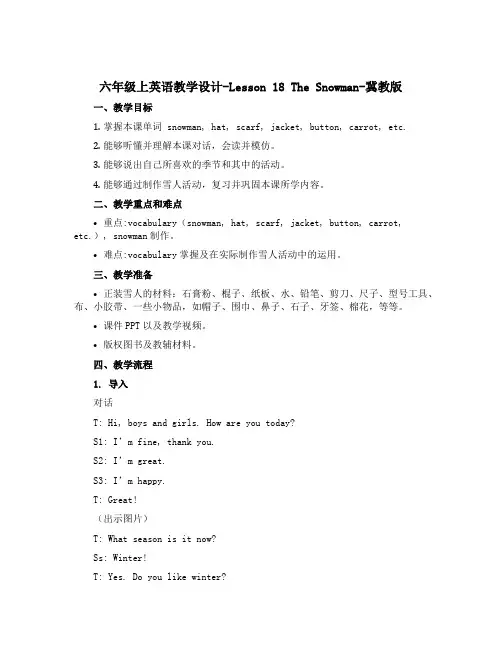
六年级上英语教学设计-Lesson 18 The Snowman-冀教版一、教学目标1.掌握本课单词 snowman, hat, scarf, jacket, button, carrot, etc.2.能够听懂并理解本课对话,会读并模仿。
3.能够说出自己所喜欢的季节和其中的活动。
4.能够通过制作雪人活动,复习并巩固本课所学内容。
二、教学重点和难点•重点:vocabulary(snowman, hat, scarf, jacket, button, carrot, etc.), snowman制作。
•难点:vocabulary掌握及在实际制作雪人活动中的运用。
三、教学准备•正装雪人的材料:石膏粉、棍子、纸板、水、铅笔、剪刀、尺子、型号工具、布、小胶带、一些小物品,如帽子、围巾、鼻子、石子、牙签、棉花,等等。
•课件PPT以及教学视频。
•版权图书及教辅材料。
四、教学流程1. 导入对话T: Hi, boys and girls. How are you today?S1: I’m fine, thank you.S2: I’m great.S3: I’m happy.T: Great!(出示图片)T: What season is it now?Ss: Winter!T: Yes. Do you like winter?Ss: Yes!T: Why?S1: Because I can play with snow.S2: I can make snowman.S3: I like skiing.……2. 学习新单词•Present the new words with flashcards and pictures, and ask students to repeat after the teacher.3. 听并理解新对话•Play the audio and ask the students to listen and follow the dialogue.•Review the dialogue and ask students to pay attention to the meaning of the new words.4. 视频展示•Show a video of how to make a snowman, and explain the process step by step.•Ask students to follow the video.5. 制作雪人STEP 1:S1: I want to make a snowman.T: Great. First, let’s make the head. (Show a picture of a round shape)S1: Ok.T: Do you have any ideas?S1: Yes, I want to put a carrot for the nose.T: Good idea. What about the eyes?S1: Buttons!T: Great! Now let’s make the body.(Show a picture of a biggerround shape)S1: Ok.T: Do you want to put any clothes for the snowman?S1: Yes, I want to put on a hat and a scarf.T: Good job! Let’s make arms for the snowman(Show a picture of two sticks)……6. 收尾讲解与小结•Review the vocabulary and the steps to make a snowman.•Ask students to name the different parts of the snowman.•Ask students to describe their snowman and share their experiences.五、作业1.写出自己喜欢的季节和其中的活动。
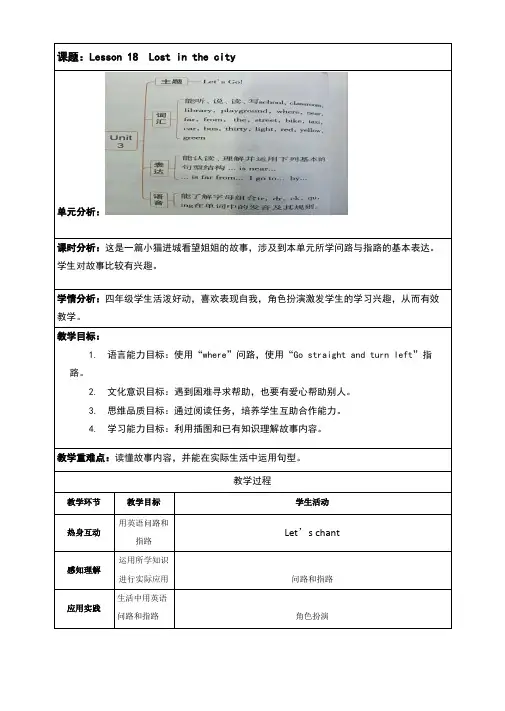
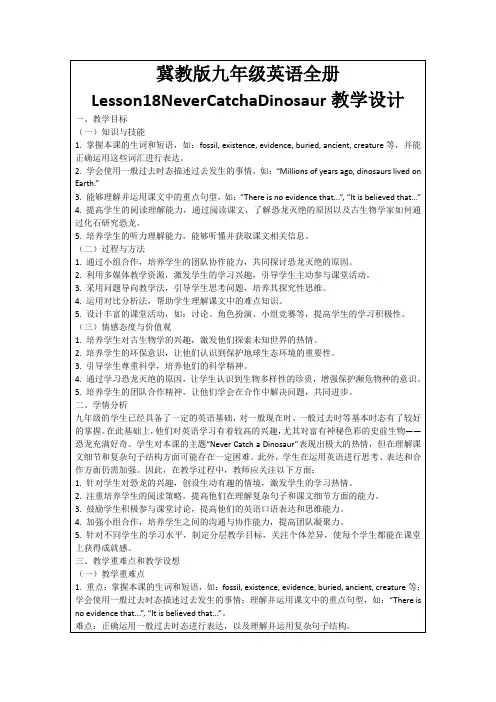
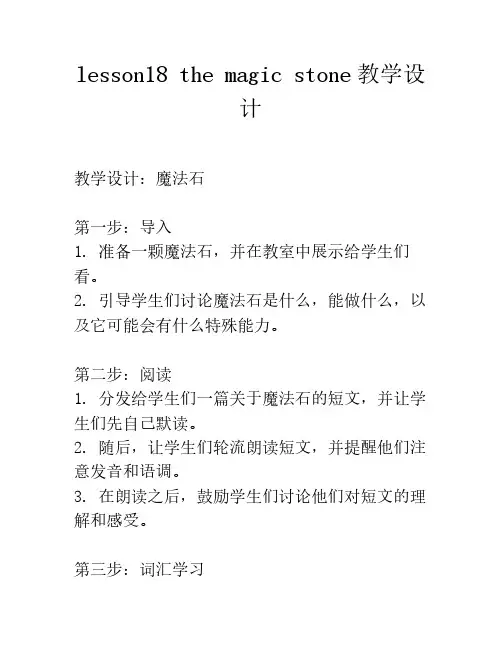
lesson18the magic stone教学设计教学设计:魔法石第一步:导入1.准备一颗魔法石,并在教室中展示给学生们看。
2.引导学生们讨论魔法石是什么,能做什么,以及它可能会有什么特殊能力。
第二步:阅读1.分发给学生们一篇关于魔法石的短文,并让学生们先自己默读。
2.随后,让学生们轮流朗读短文,并提醒他们注意发音和语调。
3.在朗读之后,鼓励学生们讨论他们对短文的理解和感受。
第三步:词汇学习1.选择一些重要的词汇,并通过图片、示意图或手势等方式向学生们介绍这些词汇的意思。
2.请学生们重复这些词汇,并尝试用英语造句。
3.创造一些与魔法石相关的句子,并让学生们填空或完成这些句子。
第四步:阅读理解1.在课堂上随机挑选几个问题,要求学生们回答这些问题,以检测他们对短文的理解程度。
2.可以使用口头提问或书面形式来进行。
第五步:角色扮演1.将学生们分为小组,每个小组有一个学生扮演魔法石的角色。
2.其他学生扮演不同的角色,如魔法师、冒险者等。
3.每个小组通过对话和角色扮演,创造出一个关于魔法石的故事或场景。
第六步:创作1.要求学生们分组,每个小组共同创作一篇关于魔法石的小故事。
2.每个小组需要包括魔法石的特殊能力、主要角色以及故事的起承转合等要素。
3.鼓励学生们用想象力和创造力来完成他们的作品。
第七步:分享与评价1.每个小组将他们的小故事分享给全班同学。
2.同学们可以互相评价和提出建议,帮助彼此改进和完善自己的作品。
第八步:总结和延伸1.教师总结整个课堂活动的内容,并强调学生们在阅读、词汇学习、角色扮演和创作等方面的表现与收获。
2.鼓励学生们在课后继续探索和发挥他们关于魔法石的想象力,比如绘制插图、写一篇续篇故事等。
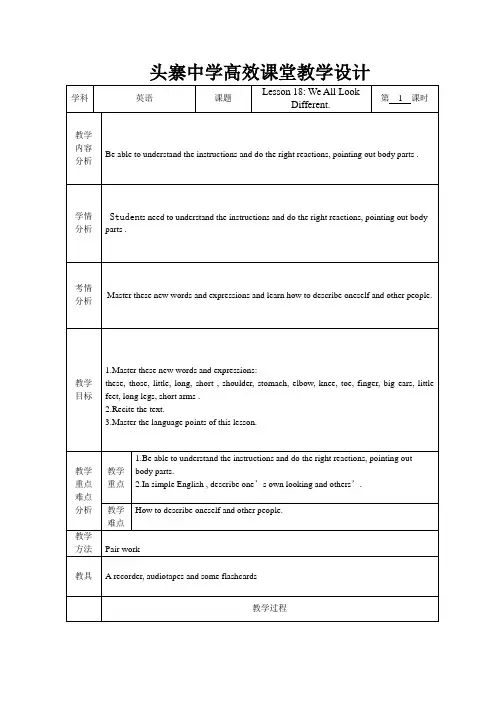
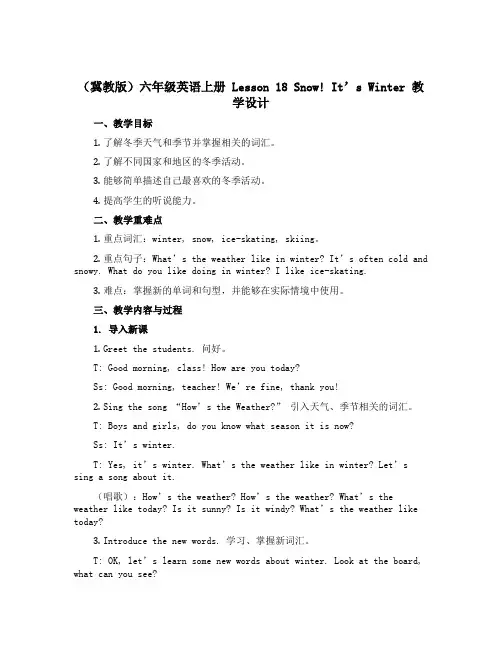
(冀教版)六年级英语上册Lesson 18 Snow! It’s Winter 教学设计一、教学目标1.了解冬季天气和季节并掌握相关的词汇。
2.了解不同国家和地区的冬季活动。
3.能够简单描述自己最喜欢的冬季活动。
4.提高学生的听说能力。
二、教学重难点1.重点词汇:winter, snow, ice-skating, skiing。
2.重点句子:What’s the weather like in winter? It’s often cold and snowy. What do you like doing in winter? I like ice-skating.3.难点:掌握新的单词和句型,并能够在实际情境中使用。
三、教学内容与过程1. 导入新课1.Greet the students. 问好。
T: Good morning, class! How are you today?Ss: Good morning, teacher! We’re fine, thank you!2.Sing the song “How’s the Weather?” 引入天气、季节相关的词汇。
T: Boys and girls, do you know what season it is now?Ss: It’s winter.T: Yes, it’s winter. What’s the weather like in winter? Let’s sing a song about it.(唱歌):How’s the weather? How’s the weather? What’s the weather like today? Is it sunny? Is it windy? What’s the we ather like today?3.Introduce the new words. 学习、掌握新词汇。
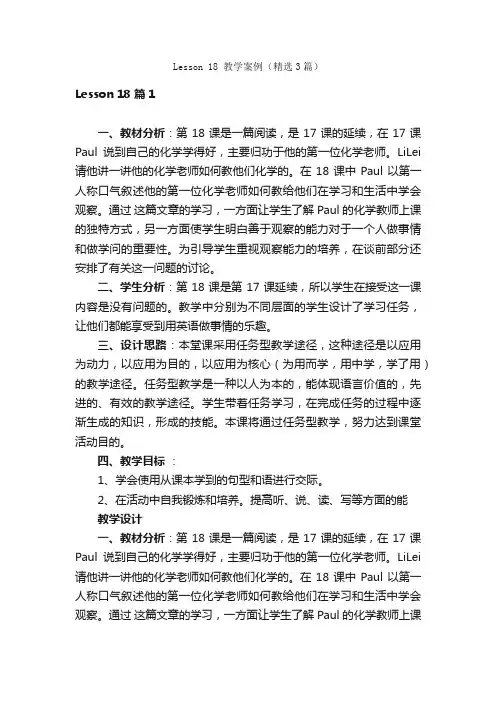
Lesson 18 教学案例(精选3篇)Lesson 18 篇1一、教材分析:第18课是一篇阅读,是17课的延续,在17课Paul说到自己的化学学得好,主要归功于他的第一位化学老师。
LiLei 请他讲一讲他的化学老师如何教他们化学的。
在18课中Paul以第一人称口气叙述他的第一位化学老师如何教给他们在学习和生活中学会观察。
通过这篇文章的学习,一方面让学生了解Paul的化学教师上课的独特方式,另一方面使学生明白善于观察的能力对于一个人做事情和做学问的重要性。
为引导学生重视观察能力的培养,在谈前部分还安排了有关这一问题的讨论。
二、学生分析:第18课是第17课延续,所以学生在接受这一课内容是没有问题的。
教学中分别为不同层面的学生设计了学习任务,让他们都能享受到用英语做事情的乐趣。
三、设计思路:本堂课采用任务型教学途径,这种途径是以应用为动力,以应用为目的,以应用为核心(为用而学,用中学,学了用)的教学途径。
任务型教学是一种以人为本的,能体现语言价值的,先进的、有效的教学途径。
学生带着任务学习,在完成任务的过程中逐渐生成的知识,形成的技能。
本课将通过任务型教学,努力达到课堂活动目的。
四、教学目标:1、学会使用从课本学到的句型和语进行交际。
2、在活动中自我锻炼和培养。
提高听、说、读、写等方面的能教学设计一、教材分析:第18课是一篇阅读,是17课的延续,在17课Paul说到自己的化学学得好,主要归功于他的第一位化学老师。
LiLei 请他讲一讲他的化学老师如何教他们化学的。
在18课中Paul以第一人称口气叙述他的第一位化学老师如何教给他们在学习和生活中学会观察。
通过这篇文章的学习,一方面让学生了解Paul的化学教师上课的独特方式,另一方面使学生明白善于观察的能力对于一个人做事情和做学问的重要性。
为引导学生重视观察能力的培养,在谈前部分还安排了有关这一问题的讨论。
二、学生分析:第18课是第17课延续,所以学生在接受这一课内容是没有问题的。
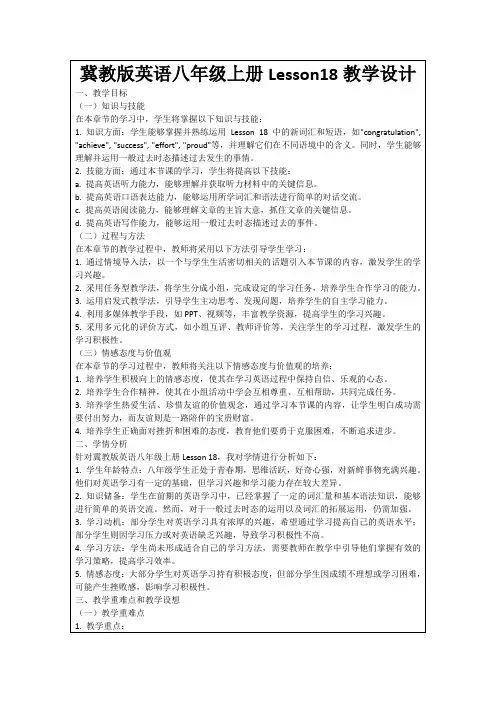
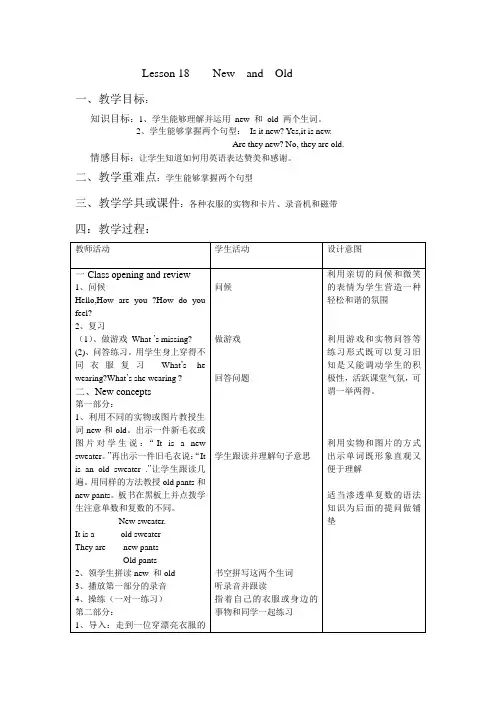
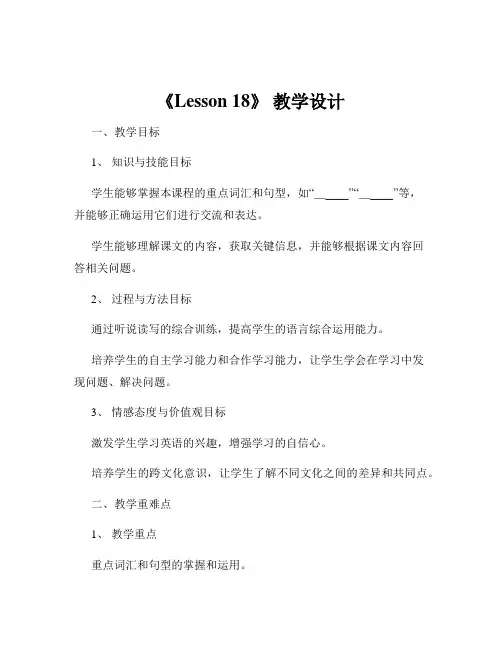
《Lesson 18》教学设计一、教学目标1、知识与技能目标学生能够掌握本课程的重点词汇和句型,如“_____”“_____”等,并能够正确运用它们进行交流和表达。
学生能够理解课文的内容,获取关键信息,并能够根据课文内容回答相关问题。
2、过程与方法目标通过听说读写的综合训练,提高学生的语言综合运用能力。
培养学生的自主学习能力和合作学习能力,让学生学会在学习中发现问题、解决问题。
3、情感态度与价值观目标激发学生学习英语的兴趣,增强学习的自信心。
培养学生的跨文化意识,让学生了解不同文化之间的差异和共同点。
二、教学重难点1、教学重点重点词汇和句型的掌握和运用。
课文内容的理解和关键信息的获取。
2、教学难点如何让学生能够在实际情境中灵活运用所学的词汇和句型。
如何引导学生理解课文中蕴含的文化内涵。
三、教学方法1、任务驱动法布置各种任务,让学生在完成任务的过程中学习和运用知识。
2、情景教学法创设生动的情景,让学生在真实的语境中感受和学习语言。
3、小组合作法组织学生进行小组合作学习,培养学生的合作能力和交流能力。
四、教学过程1、导入(5 分钟)通过播放一段与本节课主题相关的英语视频或展示一些图片,引起学生的兴趣,导入新课。
2、词汇学习(10 分钟)展示本节课的重点词汇,通过图片、例句等方式帮助学生理解词汇的含义和用法。
让学生进行跟读、拼写和造句练习,加强对词汇的记忆和运用。
3、句型学习(10 分钟)呈现重点句型,讲解句型的结构和用法,并结合实际情境进行造句练习。
鼓励学生积极参与,大胆表达。
4、课文学习(15 分钟)让学生听课文录音,初步了解课文内容。
然后,让学生阅读课文,回答一些与课文内容相关的问题,检查学生对课文的理解程度。
5、小组讨论(10 分钟)组织学生进行小组讨论,讨论课文中的一些难点问题或让学生分享自己对课文的理解和感受。
每个小组推选一名代表进行发言。
6、语言运用(10 分钟)创设一些实际的情境,让学生运用所学的词汇和句型进行交流和表达。
《Lesson 18 》说课稿尊敬的各位评委老师:大家好!今天我说课的内容是_____教材中的 Lesson 18 。
下面我将从教材分析、学情分析、教学目标、教学重难点、教学方法、教学过程以及教学反思这几个方面来展开我的说课。
一、教材分析(一)教材的地位和作用Lesson 18 是本单元的重要组成部分,它既承接了前面几课的知识,又为后续课程的学习打下了基础。
通过这一课的学习,学生能够进一步巩固和拓展已有的语言知识和技能,提高语言综合运用能力。
(二)教学内容本节课主要包括词汇、语法、阅读和写作等部分。
词汇方面,重点学习了一些与日常生活相关的新单词和短语;语法部分,涉及到了某个特定的语法结构的运用;阅读部分,提供了一篇具有代表性的文章,以培养学生的阅读理解能力;写作部分,要求学生根据给定的话题进行写作练习,锻炼他们的书面表达能力。
(三)教学目标1、知识目标学生能够掌握本节课的重点词汇和短语,如_____、_____等。
学生能够理解并正确运用本节课的语法结构,如_____。
2、技能目标通过阅读训练,提高学生的阅读理解能力,能够准确获取文章中的关键信息。
通过写作练习,培养学生的书面表达能力,能够用所学语言知识清晰、准确地表达自己的观点和想法。
3、情感目标激发学生学习英语的兴趣,增强学习自信心。
培养学生的合作意识和团队精神。
(四)教学重难点1、教学重点重点词汇和短语的记忆与运用。
语法结构的理解和正确使用。
2、教学难点如何引导学生在实际情境中灵活运用所学的语言知识。
帮助学生克服写作过程中可能遇到的困难,如语法错误、词汇缺乏等。
二、学情分析(一)学生的知识基础经过之前的学习,学生已经掌握了一定的英语基础知识,如基本的词汇、语法和简单的听说读写技能。
但对于本节课的新内容,可能还需要进一步的学习和巩固。
(二)学生的学习能力学生的学习能力存在个体差异,部分学生学习积极性高,善于思考和总结;而部分学生可能需要更多的引导和督促。
Lesson 18: Lost in the City 教学设计一、教学分析:(一)教学内容分析本课的内容选自冀教版小学英语第三册第三单元。
这是一篇关于一只小猫进城看望她的姐姐的故事。
故事涉及本单元所学的单词city,srteet,hotel,apartment,traffic lights, turn right,turn left,及问路指路的基本表达。
此外,故事在学生已有单词和用语的基础上进行了适当的拓展延伸。
(二)教学对象分析本节课的授课对象是小学四年级的学生,接触英语已经一年多了,对英语的学习有了一定的了解和知识的基础,有了初步的语言交际能力。
利用四年级学生活泼、好动、易于接受和模仿,有效注意时间短的特点,通过情景教学、角色扮演等方式延长学生的有效注意时间,尽可能多的让学生表现自己并及时给予评价,使学生获得成就感,增强自信心,激发学生学习英语的兴趣,从而达到有效教学。
二、教学目标:1、知识目标:能在图片和老师的帮助下听懂、读懂故事,复习本单元的词汇和问路指路的基本表达。
2、能力目标:能根据图片、核心单词或句子,简单的表演故事。
3、情感态度:身边的人遇到困难时,应乐于提供帮助。
自己遇到困难时,应主动寻求帮助。
4、学习策略:通过教师的指导与训练,培养学生看图预测、读文验证、表演述故事等。
三、教学重点、难点重点:通过故事学习,复习本单元所学的词汇以及问路指路的基本表达。
难点:鼓励学生运用自己已有的知识,创造性地进行表演故事。
四、教具准备多媒体课件,故事插图图片、动画、头饰五、教学过程Step 1 : Pre-reading(Revision and warm-up)1. Greeting: Hello,boys and girls. Today, I am your new teacher. My familyname is Hao, so you can call me Miss Hao. Nice to meet you!2.Read and chant:【设计意图:配以动作和节奏的小chant,生动活泼,迅速激发学生的学习兴趣并复习与故事相关的指路的基本表达。
小学英语六年级上册 Lesson 18 The Snowman 教学设计冀教版三起一、教学目标1.学习能听懂、会说、会读本课的新单词:snowman, carrot, scarf, branch, hat, coal。
2.学习能听懂、会说、会读本课的句型:What are you making? I’m makinga snowman. What are you using for the nose? I’m using a carrot.3.练习能听懂、会说、会读本课的核心句型,通过问答强化语言输入和语言输出的能力。
4.通过表演让学生自然地练习语音、语调、语音节奏。
5.小组活动中鼓励学生互相合作、交流,提高英语表达能力和口头表达能力。
二、教学内容1.单词•snowman:雪人•carrot:胡萝卜•scarf:围巾•branch:树枝•hat:帽子•coal:煤2.句型•What are you making?(你在做什么?)•I’m making a snowman.(我在做一个雪人。
)•What are you using for the nose?(你用什么做鼻子?)•I’m using a carrot.(我用胡萝卜。
)三、教学准备•教师准备PPT和雪人图片、胡萝卜图片、树枝图片、围巾图片、帽子图片和煤图片。
•准备小组活动,让学生互相交流、合作。
四、教学步骤Step 1 自我介绍•教师和学生进行简单的自我介绍,旨在让学生放松,创造轻松和谐的课堂氛围Step 2 导入新词•展示PPT上的图片,并通过听音、说音和阅读的方式让学生学习新单词:–snowman:雪人–carrot:胡萝卜–scarf:围巾–branch:树枝–hat:帽子–coal:煤•以重复和唱歌的方式强化学生对新单词的理解和记忆。
Step 3 学习核心句型•展示PPT上的图片,并通过听音、说音和阅读的方式让学生学习核心句型:–What are you making?(你在做什么?)–I’m making a snowman.(我在做一个雪人。
Lesson18 教学设计一、教学内容与分析1. Fun story本部分通过Mimi让Micky猜厨房里相关食品的风趣小故事,复现本单元的目标语言。
2. Let’s check本部分是评价检测活动。
通过听音标序号,检测学生对本单元所学的目标词汇的掌握情况。
3. Language Focus本部分列出了本单元的目标语言,区分了学生应听、说、认读和听、说、读、写的词汇和语句等,为学生自我评价、小组互评、教师检测等提供了参考。
二、课前准备1. 准备一些果蔬图片作为评价工具,奖励课堂上表现出色的学生。
2. 准备本单元的单词卡片,创设情景,进行复习。
3. 准备本课的教学课件。
三、教学步骤与建议1. 热身/复习(Warm-up/Revision)1) 师生问好。
2) 说唱上节课趣味操练部分的歌谣。
2. 新课呈现(Presentation)以Mimi和Micky为主线人物进行猜迷活动。
1) 猜谜活动。
Mimi has a big basket. There’re many kinds of fruits and vegetables in it. He’ll play a guessing game with us. Can you guess ?图片如下图所示,可以是阴影,可以是剖面,可以是轮廓。
What’s this/that in English?在师生交流中注意反问Are you sure?让学生感知其含义。
2) 引入Fun story故事。
Listen and tick the food in the story.3) 看表格问答。
两人一组扮演Mimi和Micky看表格问答:What’s this/that in English?It’s a...4) 提供Fun story图片,首先让学生观察图片并试着扮演描述。
然后看视频,跟读、模仿录音,学习故事。
3. 趣味操练(Practice)1) 多种方式引导学生体验、模仿Fun story中的语句。
(冀教版)三年级英语上册《Lesson18 Hot Cold》教学设计一、教学背景本节课是冀教版三年级英语上册的第十八课,名为Hot Cold,主要围绕天气温度的表达,让学生掌握单词hot和cold的用法以及句子的构造。
二、教学目标语言知识目标1.学生能够听懂、会说、会读单词hot和cold。
2.学生能够理解、会说并使用句型It’s hot/cold.。
3.学生能够自主运用所学知识随意表达天气温度。
情感态度价值观目标1.让学生了解天气的温度变化对人的舒适度的重要性。
2.通过课堂游戏让学生在轻松愉快的氛围中学习英语。
学习策略目标1.通过游戏形式,激发学生的兴趣。
2.引导学生在轻松快乐的氛围中学习英语,增强学习的主动性。
三、教学重难点教学重点1.hot和cold单词的发音、意思、用法。
2.掌握It’s hot/cold.这个句型。
教学难点如何引导学生能够运用所学知识随意表达天气温度。
四、教学准备1.课件。
2.单词卡片。
3.温度表。
4.简单游戏相关游戏道具。
五、教学过程1.导入(教师出示温度表)T:Hello, everyone! Have you ever seen a thermometer like this? Do you know what it is used for?(引导学生回答)Yes, it’s used to show us the temperature of the weather. Do you know the words for different temperatures?(展示单词卡片hot和cold)Today,we are going to learn about hot and cold. Do you like hot days or cold days more?2.学习T: Now we are going to learn the words hot and cold. (教师分别展示发音并让学生模仿)Hot, cold. (用ppt/黑板出示单词,并配以相关图片)These are the words we are going to learn today. Say them again with me, hot, cold.T:Now let’s learn how to say “It’s hot.” Do you know how to say it? I’ll say it first, and you can repeat it after me.(教师在黑板或ppt上展示It’s hot.并让学生跟读)It’s hot.T: Let’s practice more.(教师出示卡片,并让学生和自己一起读出来)3.运用T: Now that we’ve learned how to use the words “hot” and “cold”, let’s have a game. We’re going to form two teams. There will be a hot team and a cold team. When I hold up the word “hot”, the hot team says “It’s hot!” And when I hold up the word “cold”, the cold team says “It’s cold!”. Okay, let’s start!(边游戏边巩固所学单词和句型)4.拓展T: We learned how to say “It’s hot.” and “It’s cold.”, but how can we talk about the temperature in other ways?Can you think of something?(引导学生举出其他表达温度的句子,如It’s warm. It’s cool.等)Okay, that’s great! You guys are so clever!!5.小结T: Today we have learned the words hot and cold, and how to use the sentence “It’s hot.”、“It’s cold.”, and we have also learned howto express the temperature differently. Did you guys enjoy it?(让学生做个体验反馈,或者进行简单的调查问卷)6.作业完成课本上Page 2的小练习。
Tian’anmen Square教学设计
Teaching Material:冀教版,七年级英语第三单元第十八课
Teaching imagination:通过本课学习,要求学生掌握There be + s. +doing 及adj.变adv.的规律和有关知识。
并培养学生观察,归纳知识的能力和热爱祖国,热爱的自然的精神。
Teaching aims:
1.Knowledge and ability amis:
1).Words:loud, loudly, quiet, quietl y…
2).Phrases:see sb. doing sth.
3).Grammars:①.There be + s. + doing ②.adj. + ly → adv.
2.Procedure and teaching methods:
1).结合课本所给思考题,让学生了解文章大意。
2).通过观察,比较掌握adj.→adv.的规律及用法。
3.Feeling, attitude and worth goals:
鼓励学生在课堂小组活动中积极参与,并培养其竞争意识和合作精神以及热爱祖国,大自然的精神。
Teaching main points:
1.There be + s. + doing
2.adj. + ly → adv.
Teaching difficulty points: adj. + ly → adv.
Teaching aids:Pictures.
Teaching Methods:
采用提问、启发、讨论和归纳的教法
Teaching procedure:
Step1.Lead-in:
Showing a picture of Tian’anmen Square to the students. Then let them discuss the following questions:
1.Do you like Tian’anmen S QUARE?
2.Doyou want togo to Tian’anmen Square to flt kites?
Help them say “Yes”.Then say:Let’s go to Tian’anmen Square to f ly kites!
Step2.Teaching and acting each other:
Activity:Sowing the picture
Teacher:What can you see in the picture?
Students:Tian’anmen Square and mand people.
Teacher:Yes. There are many people playing. What are you doing? Students:They are talking ang flying kites.
Teacher:You are right. I can see some men flying kites, too. Are they happy?
Students:Yes. They are very happy.
Teacher:They are laughing loudly. They are loud.
Step3.Searching may and difficulty points:
Let them say the underline sentences,Then explain :
1. There are many people playing.
There be + s. + doing
eg:There are some people playing cards under the tree.
There is a girl singing in the classroom.
2. I can see some men flying kites, too.
See sb. doing sth.
See sb. do sth.
eg:I can see some birds flying in the sky.(看见鸟正在空中飞)
I can see some birds fly in the sky.(看见鸟曾在天空飞过)
3.观察比较下面两组句子:
1).The children are loud.(adj.)
They are laughing loudly.(adv.)
2).The people are quiet. (adj.)
They are doing their homework quietly. (adv.)
可以看出:adj. + ly → adv.
eg:The picture is very beautiful.
She sings beautifully.
Step4.Activities:
Activity 1:Let them open the books and read the passage.then discuss the following questions:
1.What are the men doing at Tian’anmen Square?
2.Can Danny fly kites?
3.What’s wrong with Danny?
Let them answer one by one.
Activity 2:Ask some groups to present the dialogue before the class. Activity3:Work with a partner to draw a map of Tian’anmen Square.The n describe the maps to each other.Try to use loudly, quietlt, slowl y and quickly.
Step5.Summary:
本文主要学习了There be结构中含有动词的用法,感官动词的用法和adj.变adv.的规律。
Step6.Homework:Fill in the black with the proper forms.
1.There is a man _ (draw) a picture.
2.There _ (be) many birds singing in the tree.
3.The bus is _ (slow).
The boy in red coat runs very _ (slow).
4.Be _ (quietly)! The boy is sleeping.
5.Ican see some people _ (play) on the playground.
Teaching feedback:
本课通过师生互动使学生掌握了文章的大意。
然后,学生通过比较和归纳以及课堂活动掌握了adj.变adv.的规律。
课堂气氛活跃,师生互动较好,体现了学生为主的新课标理念。
基本完成了教学任务。